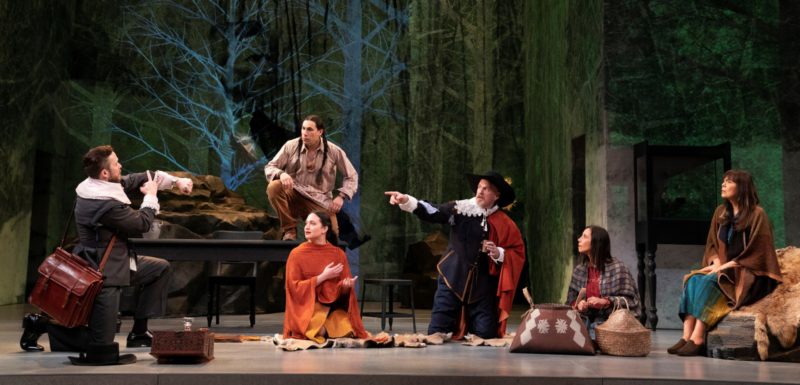Native American Playwrights Practicing Public History: New Wave History Plays
31 March 2020 – Laurie Arnold
native americans, methods, manhattan, community history, cherokee, sense of place, lenape, public history, 2021 annual meeting, theater, Indigenous People

Mary Kathryn Nagle (Cherokee), playwright and attorney. Photo credit: Justin T. Gellerson for the New York Times
It’s been five years since Hamilton: An American Musical debuted at the Public Theatre in New York, a notable moment for numerous reasons, not least of which was the ensuing (and ongoing) clamor among Americans for tickets to see a musical about history. History! And while the delivery of the history lessons included songs we like to sing and offered historical protagonists in rap battles par excellence, the history itself was fairly unremarkable, a founding fathers biography, replete with stories of American Revolution and General Washington. Historians have written thoughtful reviews of the musical and its historical content for this publication, and I cannot improve upon their analyses.
Instead, let’s turn our attention to Cherokee playwright Mary Kathryn Nagle and how she has re-purposed the history play to tell stories which are remarkable because the interpretations are Native-centered and informed by knowledge held within Native communities, features generally missing in American theatre and American history textbooks. Rather than simply being set in the past, a history play “evinces serious concern for historical truth or historical issues.” Long the purview of Shakespeare or fusty stories of empire, history plays found new life in Great Britain and Europe in the twentieth century with the rise of realism, Marxism, feminism, the Annalistes, and history from the ground up. Native American playwrights represent the newest wave in writing history plays that call upon audiences to see more, think more, and do more.[1]

“Land Grab” in “Manahatta” at Yale Rep Theatre, February 2020. Photo credit: Joan Marcus
Nagle’s play Manahatta is set in its eponymous place, on the city’s famous/infamous Wall Street in ancestral Lenape territory, and in Anadarko and Chickasha, Oklahoma. The narrative takes place in both the seventeenth and twenty-first centuries. The play illustrates permanence and change in its Lenape world, change because of lost homes and homelands, permanence because culture and community persist regardless of geography. The Lenape moved again and again in the centuries after being forced out, and they formed new home communities across Canada and the United States.
Jane Snake grew up in Oklahoma and is an accomplished MBA embarking on a new career at Lehman Brothers in 2002. Her seventeenth-century Manahatta ancestor is Le-le-wa’-you. The same actor performs as both characters. In New York, Jane is challenged by the corporate culture, by the laissez-faire attitudes of her bosses toward unsecured mortgages, and by the dissonance of living in a place her ancestors knew intimately while she rarely has time to look outside. One of Jane’s bosses is Dick Fuld, CEO and chairman of Lehman Brothers at the time of its bankruptcy. His seventeenth-century counterpart, with a single actor in both roles, is Peter Minuit, Dutch West India Company governor. In Oklahoma, Jane’s mother Bobbie gets caught in a bad mortgage and ends up losing the family home. We see Bobbie, as well as her seventeenth-century counterpart, pushed out of their homes by men who attribute the evictions simply to the market forces of their era. Peter Minuit/Dick Fuld profit from their respective booms but deny culpability for loss of family homes and lifeways.
For Nagle, the 2008 housing crisis was the latest iteration of the greed which resulted in Lenape people being forced from their homes four centuries ago. An attorney, she worked in a Manhattan firm and witnessed the outcry over the housing crisis. Nagle wondered, “How do you critique Wall Street as an institution when it began as an institution that took homes from the Lenape? That no one talks about.” A single actor playing two roles has become one of Nagle’s trademarks as a playwright. She describes this approach as creating a shorthand for the audience. When Peter Minuit and Dick Fuld are personified by the same actor, for example, audiences are more likely to understand that Nagle’s critique of both is the same.
Historian David Dean has argued that theatre can be an important site for public history, and Manahatta makes that case quite clearly.[2] This 90-minute production, which first premiered at Oregon Shakespeare Festival (OSF) in Ashland and most recently at Yale Rep in New Haven, teaches Lenape history informed by Lenape oral tradition and in collaboration with Delaware Nation elders. Nagle also modeled best practices in Native American theatre when she made space for Curtis Zunigha, a Lenape language and cultural consultant, to join the production at OSF. He participated in the rehearsal process and in the workshop. Thousands of people saw Manahatta; how many of them would have encountered Lenape-centered history without Nagle and Zunigha?
Critics observed audiences learning, or at least noted audiences seemed prepared to learn. At Oregon Shakespeare Festival, “it seemed as though the mostly white audience was split in their receptivity to what they were seeing onstage. There was a sense of coming face to face with a repulsive personal history… That is as close to a perfect moment as real theater can come.” In New Haven, “Manahatta’s best move is to let no one off the hook — particularly the largely white audience members in attendance on opening night.” Both critics wondered what comes next for audience members after leaving a production infused by history, loss, and ultimately restoration.
None of us can know precisely what audiences take from our work, but we do know that public history offers frameworks for interpretation which can lead to revitalization of histories too long absent from public view. The 2021 NCPH conference theme, “The Presence and Persistence of Stories,” was informed by our very real responsibilities as historians to understand narrative in context of place. Manahatta implicitly and explicitly reminds us how stories divorced from their settings lose their memories.
Theatre has been too long overlooked as a meaningful interpretive site; David Dean argues that actors, directors, and dramaturges function as historians when they perform history on stage.[3] I add playwrights to Dean’s list. Native playwrights expand this historical dialogue even more because they are remaking American theatre with historical narratives that general audiences have either forgotten or never learned. In the previous decade, playwrights including Nagle, DeLanna Studi (Cherokee), Larissa Fasthorse (Sicangu Lakota), and Randy Reinholz (Choctaw), among others, have written plays about the Cherokee Trail of Tears, federal Indian boarding schools, Thanksgiving, treaties, tribal jurisdiction, and the Violence Against Women Act (VAWA). These narratives confront the past as well as illuminate it, like good history should. They assert tribal political and cultural sovereignty and in doing so, they enhance our comprehension about multiple and various tribal histories and perspectives. I’ve seen eleven productions of eight plays by Native playwrights in the last few years and at the end of each one I felt energized and hopeful and, yes, a little spent by all that I had learned in two hours in a darkened room shared with a few hundred other viewers.
This work, interpreting history for the stage, is tremendously important. The NCPH friends I know are able researchers, keen collaborators, and great community partners, and I hope many will join me in offering these skill sets to Native playwrights when their work intersects with ours. They know stories we don’t. In the words of Susan Power (Standing Rock Sioux), “We were there. Always there. Still here.”[4]
~ Laurie Arnold is an enrolled member of the Sinixt Band of the Colville Confederated Tribes. She is director of Native American Studies and an associate professor of history at Gonzaga University. Her research interests include contemporary Native American drama, the Indigenous Columbia Plateau, and federal Indian policy.
[1] Niloufer Harben, Twentieth-Century English History Plays: From Shaw to Bond (London: Macmillan Press, 1988), 18-19.
[2] David Dean, “Theatre as a Neglected Site of Public History,” The Public Historian 34, no. 3 (Aug. 2012): 37.
[3] Ibid., 21-22.
[4] Susan Power, “Convocation,” Grinnell College, Grinnell, IA, November 1999, quoted in LeAnne Howe, Choctalking on Other Realities (San Francisco: aunt lute books, 2013), 35.



